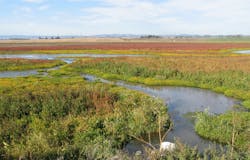Platform Connects Investors with Monterey Bay Storm Water Projects
About the author:
John Hunt, Research Toxicologist, UC Davis, and Chief Science Officer, Aqaix. [email protected]
A group of scientists and water project planners seeking to improve water quality in tributaries flowing into ecologically diverse Monterey Bay have partnered with Silicon Valley software company Aqaix to gain access to public and private funders. The group, which needs $73 million for 17 multi-partner, multi-benefit water projects, is using Aqaix’s highly innovative cloud platform to connect with “impact” investors – a new breed of funders interested in bringing about environmental and social progress through their investments. Critically, the platform – known as the Aqaix Digital Finance Marketplace – allows project planners to demonstrate the environmental benefits or ROI (return on investment) of projects aligned in an integrated, watershed-based portfolio.
“We are finding that private investors are looking for projects like ours that have real world returns in terms of environmental benefits,” said Ross Clark, director of the Central Coast Wetlands Group. “But until Aqaix, there’s been no way for us to introduce our projects to these impact investors. The Aqaix platform allows us to show funders – both private and public – the social and environmental return on investment they will get if they put capital into our projects. Aqaix has opened up the investment universe to us.”
Aqaix CEO Michael Gardner said, “Ross and the rest of his group need to operate their finance campaign at scale, and the key to scale is software. What Aqaix offers is software to manage the funding of water infrastructure, just as, say, Salesforce offers software for companies to manage their sales processes.
“At the same time, the software provides transparency to impact investors,” Gardner continued. "It allows investors to see exactly how their investments are benefiting ecosystems and improving quality of life for the communities around Monterey Bay that need cleaner water and more dependable supply. This is key because as the climate crisis worsens, the investment world is seeing a very clear and sharply accelerating trend toward impact investing, and these investors want to see documented social and environmental ROI.”
California's Monterey Bay is one of the most biologically productive marine environments on Earth. The bay is a feeding and breeding ground for magnificent humpback whales, leatherback sea turtles, sea otters and dozens of other iconic marine creatures. However, many tributaries to the bay are impaired by high concentrations of nutrients, pesticides, industrial compounds, algal toxins and other contaminants. A particular concern is nitrogen-contaminated storm water runoff from surrounding urban and agricultural areas.
The group of local scientists, engineers, data managers and planners are trying to address contamination of tributaries flowing into the bay by developing digital master plans for Monterey Bay watersheds. These master plans evaluate the network connections in hydrology, land use, habitat, community organization, administrative authority, infrastructure and financing to create integrated portfolios of projects that can be evaluated and prioritized based on the benefits they provide and their suitability for different sources of financing.
In addition to hydrologic modeling and geographic analysis, the master plan that includes the initial 17 projects will also be the basis for monitoring to verify achieved benefits once the projects are completed. The California central coast has a number of water quality monitoring programs that produce high quality, comparable data delivered to a regional data center and statewide database. Using these data and cutting-edge studies of nutrient reduction in treatment wetlands and other systems, the master plans are beginning to create digital twin systems, which create digital simulations of watershed processes to estimate project benefits, particularly for reductions in nutrients and algal eutrophication. This capacity is being enhanced by initial deployment of a nutrient monitoring sensor network in target reaches of the watershed.
The group of scientists and water project planners is now working to secure the $73 million necessary to implement the 17 projects. The strategy is to seek about $36 million from California’s bond-funded funds, but that financing will require equal matching funds raised by the group. Much of that matching funding will probably come from local governments and agencies, but the group also intends to raise funds from donors and commercial investors.
That raises two challenges: 1) How to run “blended finance” (capital from many types of sources) across the whole portfolio, rather than leave each project on its own to find funding; and 2) How to efficiently manage a fundraising campaign in a “transboundary” situation involving hundreds of decision makers from scores of agencies, nonprofits, and companies.
To meet these challenges, the group has employed the Aqaix Digital Finance Marketplace. The Marketplace provides a single, cloud location where the portfolio of 17 projects is accessible to funders, people within the group, and even the public. Through the Marketplace, group members can market the projects to public and private funders, employ data to show the benefits of projects and avoid the inefficiencies and confusion that come from emailing spreadsheets around to hundreds of recipients and participants.
While the marketplace can serve commercial investors and government agency staffers, it also supports impact investors. The Marketplace’s data integration architecture can quantify the specific social and environmental ROI that impact investors consider. A project’s score can be algorithmically computed, based on the water project planners’ modeling, and then displayed through an Aqaix “badge,” which translates those scores into more easily comprehensible visual symbols.
The Marketplace includes data integration features that allow for pay-for-performance models and can function as a system of record to hold data used in legally binding contracts and financing covenants. For example, a loan repayment interest rate could increase if the agreed-upon data in the platform shows that a targeted nitrogen reduction level is not achieved by the project over time.
“In addition to transactional efficiency,” Gardner said, “the Marketplace also allows funders to make evidence-based decisions about financial investments. That may involve, for example, using data to see the current level of nitrogen in water near a project site, or to see at a glance what the expected nitrogen reduction is for a project. The Marketplace makes projects transparent,” Gardner continued, “and it is software to manage stakeholder communications, which is critical to getting these projects funded. Public and private funders, even the general public, can see social and environmental ROI as well as economic ROI.”


